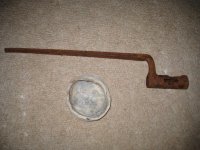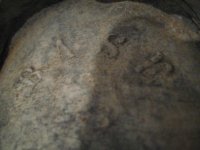Congratulations! You've found the bottom of a very-very rare Wiard canister.

See the photo and info on page 66 of my book "Field Atillery Projectiles of the American Civil War - Revised & Supplemented 1993 Edition."
Have you measured its diameter? In your photo, the bayonet's size indicates you Wiard Canister base is larger than 3 inches.
Also, the faint rifling-marks don't match up with the number of grooves from any version 3"-caliber rifled cannon. It appears to show 15-groove James type rifling, which means it was fired from either a 3.8"-caliber James rifle or a "retro-rifled" 6-pounder smoothbore ...not a 3.6"-caliber Wiard rifle.
Sidenote:
Some of Wiard's 3.6"-caliber rifled cannons had 12-groove rifling ...but your canister-base appears to have 15 rifling-grooves. Please let me know if my eyeball-estimate of 15 is correct, or if your base actually has 12 rifling-marks.
All of that having being said... the designer of this model of Canister, Norman Wiard, is known to have produced at least four 3-inch caliber rifled cannon. Thus, it's at least "theoretically" possible that he also produced a 3"-caliber version of his Canister ammunition. But, as mentioned, the rifling on your specimen's sides doesn't seem to match up with any known 3"-caliber cannon's rifling. So, I'd suspect that the marking on your Wiard canister-base originally said 3.6 inch, and the ".6" is no longer readable.
Please make the best estimate you can of your relic's diameter, and let me know.
Also, if you wouldn't mind, let me know what battlefield it came from. Please be assured, I'm NOT asking you for the exact spot of land you dug it on. Purely for Historical Research data, I'm asking for just the name of the battle, and anything you know about when that particular battle-action took place.
Regards,
Pete [P.C. George]



